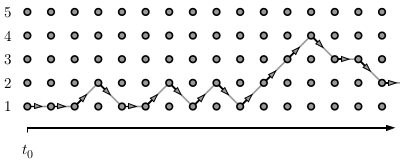Diffusion.py
From Werner KRAUTH
| Revision as of 09:22, 9 June 2024 Werner (Talk | contribs) (→Context) ← Previous diff |
Revision as of 10:14, 9 June 2024 Werner (Talk | contribs) Next diff → |
||
| Line 3: | Line 3: | ||
| We consider a particle diffusing on a path graph with five sites, always starting at position i = 0, at time t=0. Arrows go "down", "straight" and "up" with equal probability. In application of the Metropolis algorithm, an arrow that goes outside the range [0, N - 1] is rejected, that is, replaced by a straight arrow. The stationary distribution of this reversible Markov chain is uniform on the N sites, because the probability to move from site i to site j equals the probability to move from site j to site i. | We consider a particle diffusing on a path graph with five sites, always starting at position i = 0, at time t=0. Arrows go "down", "straight" and "up" with equal probability. In application of the Metropolis algorithm, an arrow that goes outside the range [0, N - 1] is rejected, that is, replaced by a straight arrow. The stationary distribution of this reversible Markov chain is uniform on the N sites, because the probability to move from site i to site j equals the probability to move from site j to site i. | ||
| + | |||
| + | [[Image:One d single.png|left|600px|border|Diffusion on a path graph with 5 sites.]] | ||
| + | <br clear="all" /> | ||
| ==Python program== | ==Python program== | ||
| Line 29: | Line 32: | ||
| ==Further Information== | ==Further Information== | ||
| - | Rather than to start at the 'bad' initial configuration i(t=0) = 0, one might be tempted to start it in the middle, but this contradicts the fact that, in real applications, one cannot usually choose a "good" initial configuration. One may also want to replace the 'bad' initial configuration by a random initial configuration i(t=0) = choice(0, ... N - 1). But this would mean that we do not have to do Markov-chain sampling at all, because a direct-sampling strategy is available. All this was discussed in detail in the lectures, and gave rise to lively discussions. | + | * Rather than to start at the 'bad' initial configuration i(t=0) = 0, one might be tempted to start it in the middle, but this contradicts the fact that, in real applications, one cannot usually choose a "good" initial configuration. |
| + | * One may also want to replace the 'bad' initial configuration by a random initial configuration i(t=0) = choice(0, ... N - 1). But this would mean that we do not have to do Markov-chain sampling at all, because a direct-sampling strategy is available. | ||
| + | |||
| + | All this was discussed in detail in the lectures, and gave rise to lively discussions. | ||
Revision as of 10:14, 9 June 2024
Contents |
Context
This page is part of my 2024 Beg Rohu Lectures on "The second Markov chain revolution" at the Summer School "Concepts and Methods of Statistical Physics" (3 - 15 June 2024).
We consider a particle diffusing on a path graph with five sites, always starting at position i = 0, at time t=0. Arrows go "down", "straight" and "up" with equal probability. In application of the Metropolis algorithm, an arrow that goes outside the range [0, N - 1] is rejected, that is, replaced by a straight arrow. The stationary distribution of this reversible Markov chain is uniform on the N sites, because the probability to move from site i to site j equals the probability to move from site j to site i.
Python program
import random
import matplotlib.pyplot as plt
N = 5
data = []
tmax = 10
for stat in range(100000):
pos = 0
for t in range(tmax):
pos = min(max(pos + random.choice([-1, 0, 1]), 0), N - 1)
data.append(pos)
plt.title('diffusion starting at $x=0$, $t = $' + str(tmax))
plt.hist(data, bins=N, range=(-0.5, N-0.5), density=True)
plt.savefig('diffusion.png')
plt.show()
Output
Here is output of the above Python program. Although the stationary distribution is flat, as discussed above, the distribution pi^t, at finite times t is biased towards the initial configuration i(t=0) = 0. The below figure shows
Further Information
- Rather than to start at the 'bad' initial configuration i(t=0) = 0, one might be tempted to start it in the middle, but this contradicts the fact that, in real applications, one cannot usually choose a "good" initial configuration.
- One may also want to replace the 'bad' initial configuration by a random initial configuration i(t=0) = choice(0, ... N - 1). But this would mean that we do not have to do Markov-chain sampling at all, because a direct-sampling strategy is available.
All this was discussed in detail in the lectures, and gave rise to lively discussions.

